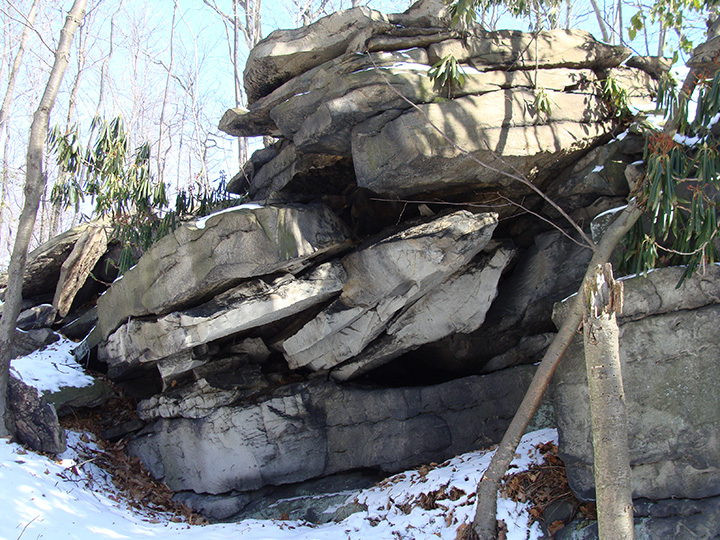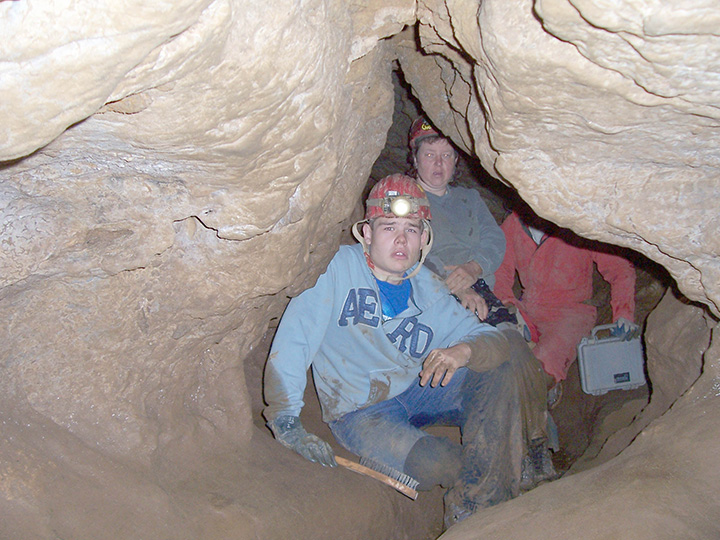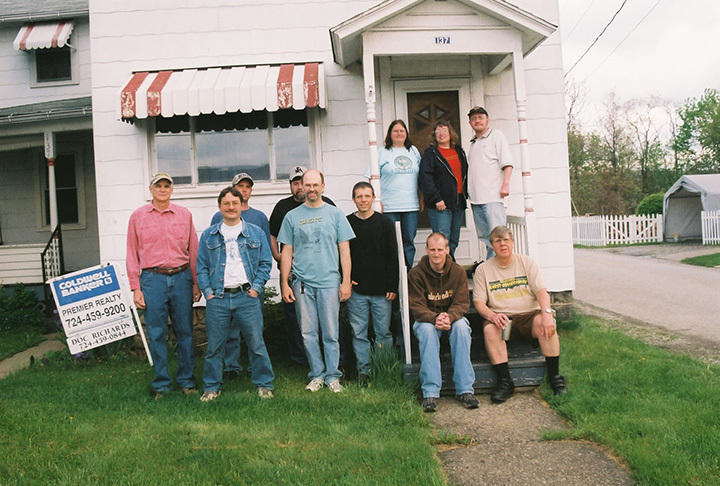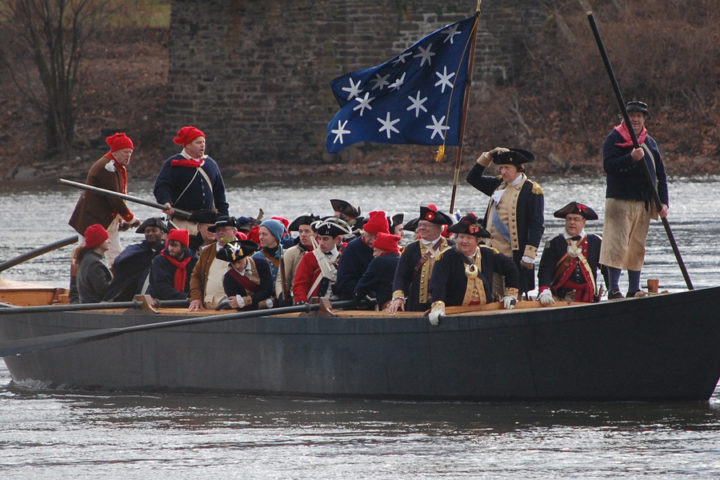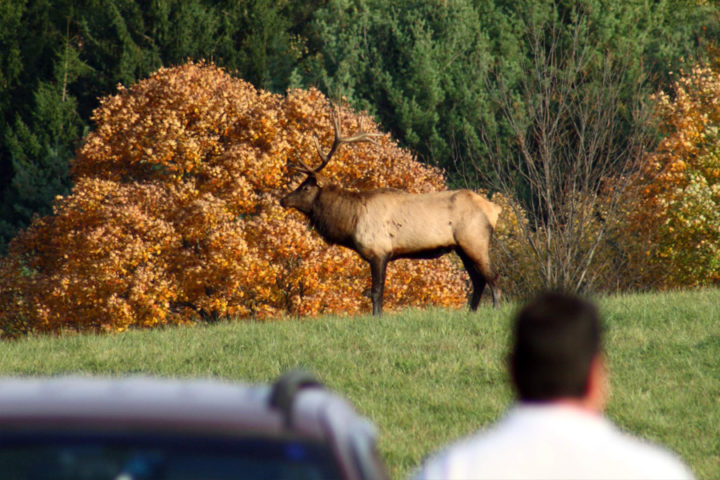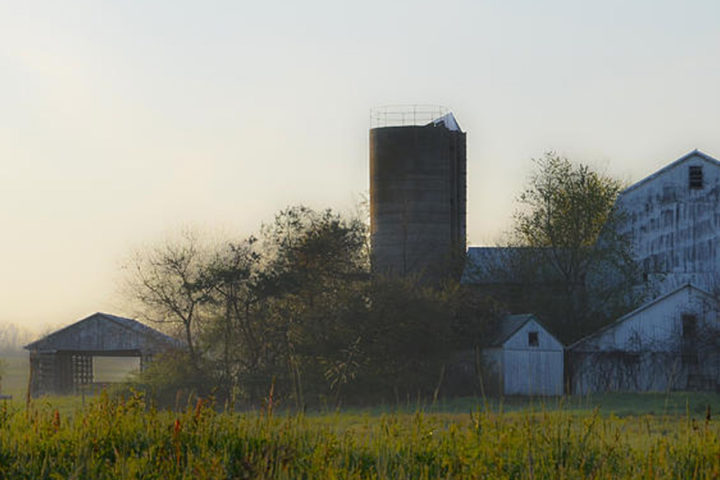Hall Cave has been a popular caving site since the 1960s. Innumerable cavers have trekked across Bill and Martha Anderson’s land to visit the cave. Bill serenaded many of them. His harmonica renditions of “You are My Sunshine” and other old-time songs are legendary in the caving community. And he let you wash your boots off in his basement upon return.
“We’ve had scouts and Penn State’s conservation group—we had so many groups go explore the cave,” Bill said. “But we’re up in years and we can’t take care of it the way we used to.”
The Andersons approached a Conservancy volunteer to see if he knew of a cave enthusiast who would want to buy their property. Although the Conservancy was young and poor, the members felt they had to seize the conservation opportunity.
Eeeeekkk! What’s that sound? I look around in the dark. My hard hat cracks against the rocks above me, and my dim miner’s light flickers across the cave walls. I lay on a cool muddy rock shelf, my feet dangling in the darkness.
Oh, it was me. I haven’t heard that sound since I was eight.
Somehow my screech gives me the strength to throw my leg behind me and wedge it against a wall.
As I pull my body upright and stand tall with accomplishment, I understand — for the first time — why people love to go caving. I am having a blast in Hall Cave.
I wasn’t the first to claw my way up Hall’s seven-foot muddy walls or to slide down screaming. Many have negotiated Hall’s narrow crawls through rock tunnels and deep, deep mud. Into this cave have gone countless cavers, scientists, youth groups, and just 24 hours earlier, an entire Girl Scout troop.
Many more will visit the cave in coming years, thanks to the Mid-Atlantic Karst Conservancy, which owns and manages the cave.
“We are trying to keep caves open so that our children and future cavers have a place to go,” said Kim Metzgar, a Conservancy founder and former board member. “We are interested in caves as conservationists. We want to preserve caves for clean water and so cave creatures are protected.”
Kim and other cave enthusiasts formed the Mid-Atlantic Karst Conservancy in 1997 to protect caves from being closed to the public — or worse — ruined. The Conservancy negotiates leases with cave owners or, as in the case of Hall Cave in Huntingdon County, it buys caves and the lands above them. Hall Cave was the Conservancy’s first purchase.
Caves are home to rare and odd species and, of course, fantastic rock formations created drip-by-drip over thousands of years. Caves are also often crucial to clean water as their streams resurge as springs out of hillsides.
Do More than Protest
Kim and Tom Metzgar spent their honeymoon planning a way to save Copperhead Cave. Particularly, they wanted to protect Trout Run, a Westmoreland County stream emanating from the limestone below the cave.
The Metzgars attended a meeting of people who were concerned with a proposal to mine away the limestone walls, floor and ceiling of the cave. The meeting was one of many attended by cavers and other concerned residents.
“Certain areas are more sensitive than others. We don’t expect to save every cave,” said Kim. “In Copperhead Cave’s case it was not just about the cave, it was about water supply.”
Trout Run feeds the reservoir that supplies drinking water to 5000 customers of Blairsville. Mining the cave would not only pollute the water; it would also destroy the natural conduit of the water supply.
“We knew that if they mined the limestone walls of the cave, it would be like removing the water supply pipe leading to a house,” Kim said. “You might have water, but it will probably come through your basement.”
It took eight years to resolve, but four citizen’s groups did succeed in stopping the limestone mining project by 1998.
And the idea of forming the Mid-Atlantic Karst Conservancy (MAKC) was sparked.
“We felt that there were threats like this to caves all the time,” said Kim. “All of them may not be significant, but we needed to do more than protest.”
The Conservancy now manages six caves, four of those in Pennsylvania.
Karst is an irregular limestone area where water has dissolved limestone, creating caverns, underground streams, fissures and sinkholes.
Conserving Hall Cave
Hall Cave has been a popular caving site since the 1960s. Innumerable cavers have trekked across Bill and Martha Anderson’s land to visit the cave. Bill serenaded many of them. His harmonica renditions of “You are My Sunshine” and other old-time songs are legendary in the caving community. And he let you wash your boots off in his basement upon return.
“We’ve had scouts and Penn State’s conservation group — we had so many groups go explore the cave,” Bill said. “But we’re up in years and we can’t take care of it the way we used to.”
The Andersons approached a Conservancy volunteer to see if he knew of a cave enthusiast who would want to buy their property. Although the Conservancy was young and poor, the members felt they had to seize the conservation opportunity.
A few thousand dollars loaned by two board members and a fund drive resulted in the money needed to buy the property.
“We formed with 11 members, pitching in $10 each. We expected to buy a cave, but not within 8 months of forming the Conservancy,” Kim said. “The Andersons are really good folks. They could have gotten a lot more money for their land.”
Bill Anderson explained: “The Mid-Atlantic Karst Conservancy wanted to preserve it for the future and for youth. That’s the part we wanted to see.”
The Conservancy may have made the purchase right in time. Huntingdon County’s wildly popular Raystown Lake has spurred development of second homes and resorts. Hall Cave would surely have been closed to make way for construction if it had not been conserved.
Overall, the Andersons had a positive experience in the years they owned Hall Cave. Other landowners haven’t been so lucky. Vandalism, littering and liability issues cause many to close caves off to the public.
“Property owners have told us that we were the first people that asked permission to go in. These kind of pressures cause people to get angry and close caves,” said Kim.
Closing caves means that generations of people won’t have the adventure and the education of entering a wild cave.
Ann Molosky, owner of Lincoln Caverns, a commercial cavern a short distance from Halls, is a volunteer for her local Girl Scouts. She runs education programs on groundwater, cave critters and cave safety before taking her teenage scouts for a caving adventure in Hall.
“It’s wonderful that there’s a group like MAKC to allow us access to a wild cave,” she says.
Creatures in the Dark
Caves, previously the realm of geologists and cavers, are gaining popularity with biologists. It turns out that these dark environments — once thought to have little life — actually host a variety of odd creatures.
Scientists have discovered bacteria that help form crystals and eat sulphur and other microbes that look hopeful in creating cancer drugs.
The best-known cave inhabitant is of course the bat. They too are contributing to medical research.
“They’re studied for the development of instrumentation for the blind using bat echolocation systems. Researchers are looking at bat enzymes that may be useful as medicines for heart and stroke victims,” said Jim Kennedy, cave resources specialist for Bat Conservation International based in Austin, Texas. Jim is a Pennsylvania native and long-time caver.
Jim added, “Pennsylvania has about 1,200 known caves and only 10 percent of those are suitable for large numbers of bats.”
These caves should be protected — if only to protect our own skins. Bats can consume up to 1,200 mosquito-sized insects an hour. And considering they feed for several hours an evening, that’s effective insect control.



